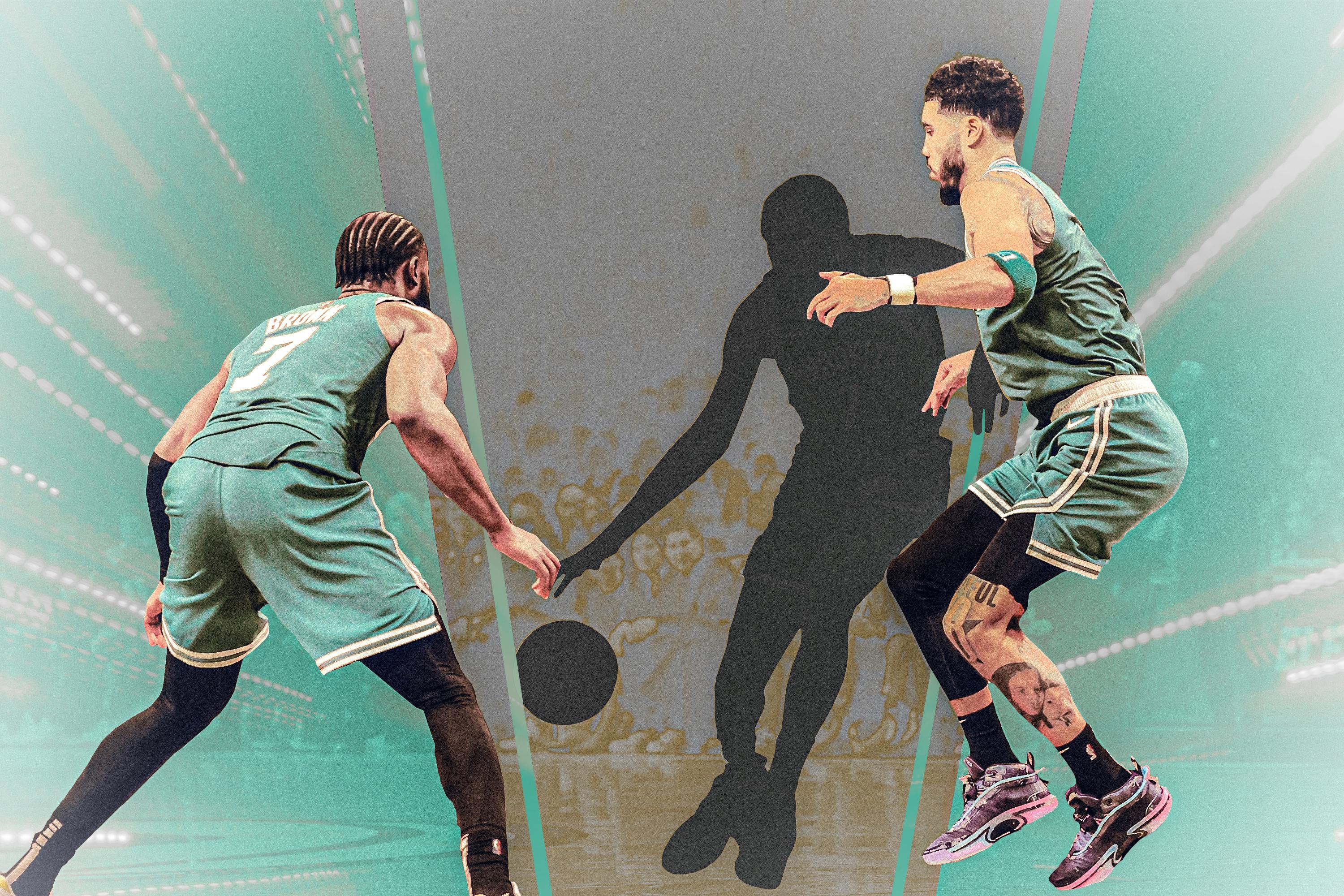
Here’s one way to contextualize how dominant the Boston Celtics have been scoring the ball. Not only are they the most efficient team the NBA has ever seen, but also, right before their 25th game tipped off against the Raptors on Monday night, their offensive rating was 8.39 points per 100 possessions above the league average. The only team since 2000 more productive relative to their direct competition was the 2003-04 Mavericks.
Coached by the innovative Don Nelson, those Mavs were led by 25-year-old Dirk Nowitzki and 29-year-old Steve Nash. An outlier offense wasn’t enough, though. Dallas was otherwise forgettable that season. The Mavs fell in the first round, with a deficient defense that couldn’t guard anyone and somehow allowed a higher effective field goal percentage than the one they filed.
I don’t think the Celtics are going to have that problem. The story of their season so far is a historic offense. The juicy subplot, though, is how balanced they can still be. After spending the first month of this season with a below-average defensive rating, the Celtics currently rank ninth. But their remaining room for defensive improvement is even scarier than the barrage of 3s they rain down every night. They’re fifth over the past 15 games, first against top-10 offenses, and quality in transition.
By rediscovering that same unyielding identity that carried them to a 2-1 Finals lead last June, a 21-5 juggernaut may be on the verge of irreproachable supremacy. Just ask the Suns. “The defense is slowly coming back,” Celtics head coach Joe Mazzulla said after his team’s most impressive defensive performance of the season, in Brooklyn last Sunday. “And our guys are doing a great job executing it.”
These Celtics haven’t needed great defense to prevail. But things were a little different last season. After starting the 2021-22 season 25-25, they treated every defensive possession as if a bucket would immediately result in a loss. Those Celtics were do-or-die, turning offensive sets into a territorial battle for personal space. Nothing was ceded without confrontation.
Boston had a great offense in the regular season, but stops were oxygen. With all their versatility, length, instincts, experience, and physicality, defense is how they separated themselves from the pack. It was also an exhausting way to exist—especially if you’re someone like Marcus Smart, whose body will disintegrate if it exerts as much energy as his brain wants it to on every possession. Now, their ability to answer any surrendered basket with an immediate open 3 makes it easier to embrace a less hostile mentality. Integrating new players and getting a feel for their rookie head coach are real adjustments that take time, too.
Offense was their greatest concern during the offseason. It’s what their coaches and players fixated on. How could they prevent the same Finals collapse (and near conference finals collapse) from happening again? With that problem apparently solved, it’s a good time to remember that they won’t be average on defense forever. A leap is brewing. One reason: Robert Williams III, a bouncy shot-blocking phenom whose return from knee surgery is imminent. He hasn’t played a second this season; that’s no minor absence. Last season, the Celtics allowed a suffocating 0.84 points per half-court play with him. This season, they’re 20th in half-court defense.
If not for a torn meniscus in March, Williams would probably be the reigning Defensive Player of the Year, largely thanks to how he turned floaters into volleyball bumps. Life is harder when he isn’t patrolling the paint. Last year, opponents made only 35.6 percent of their short midrange shots. That number easily led the league. Right now they’re at 46 percent, which is fourth worst.
Also, compared to last season, Boston is allowing opponents to attempt about two more driving layups per 100 possessions. Williams is a hesitation-maker if there ever was one. Opposing ball handlers aren’t hesitating anymore. Stuff like this doesn’t happen when he’s out there.
And then there are his replacements: Luke Kornet, Noah Vonleh, and Blake Griffin. Boston’s defense with either of the latter two has been abysmal. Kornet is solid (especially when it comes to his unorthodox closeout technique) but … not Rob Williams.
Time Lord’s impact is undeniable, but he’s less a savior than someone who authorizes permanent access to the NBA’s penthouse. His presence injects an aura of invincibility into what should already be an elite group. Even when he’s unavailable, this roster still has an abundance of above-average, flexible, stout individual defenders in a system that should yield a top-5 rating (which is what they have when Jayson Tatum is on the floor).
Almost their entire rotation can be short-listed for an All-Defensive team: Tatum, Smart, Grant Williams, Jaylen Brown, Al Horford, Derrick White, and Malcolm Brogdon. (With so many strong links, Sam Hauser is routinely attacked on an island—he’s defended more isolations per 100 possessions than almost anyone else who’s logged at least 30 plays, per Second Spectrum—but has been holding up well.) Until their most influential defender returns, there are several signs that this team is on track to finish much closer to where last season’s Celtics ended up than they currently are.
Boston’s quantified opponent shot quality (a metric that weighs the 3-adjusted probability of an average shooter making the shot) was a league-best 50.75 percent in 2021-22. This season, it’s 50.68, which only trails the Bucks and is a major reason Mazzulla generally likes what he sees. When I recently asked him if there was any difference in Boston’s mentality compared to last season, Mazzulla drizzled a detailed list of basic and advanced statistics into an optimistic response about the trajectory his group is on, from their climbing defensive rebound rate to how they’ve done a better job of keeping their hands active and creating turnovers (though in that department they still rank near the bottom).
“There isn’t a difference between here and last year,” he said. “With the exception of we don’t have Rob.” The Celtics are forcing the shots they want, nearly duplicating the opponent shot frequencies posted last season. They’re good at taking away the rim and corner 3s while cajoling a heavier diet of midrange jumpers than any other defense. If they keep it up, simple math will push them into a higher tier.
And their calling card remains their calling card. “Our schemes, you know, for the most part remain the same,” Mazzulla said. They’re switching on- and off-ball screens at a slightly higher frequency than last season. (Only the Nets do it more often.) One of the biggest reasons is it induces hero ball from players who have no business going one-on-one, vaporizing flow and ball movement. The Celtics allow just 21.7 assists per 100 possessions, which is second only to Milwaukee.
“Game plan execution. Defensive discipline. Details to tendencies. Active hands,” Mazzulla said. “I just thought our guys … they play hard all the time.”
It sounds preposterous to look at anything the Celtics have done and then call them a sleeping giant. But for as ridiculously efficient as their offense has been, the steady progress they make in-season on the other end may eventually be the primary reason they’re regarded as an all-time powerhouse.
It’s their defense that can’t be overlooked. It’s their defense that keeps them in every game and completely discombobulates opposing strategies. It’s their defense that can take them wherever they want to go. A cement foundation. And at the end of the day, nothing scares every other contender more than the Celtics getting back to the level they discovered on that side of the ball during the back half of last season. The rest of the league may need to brace themselves all over again.

